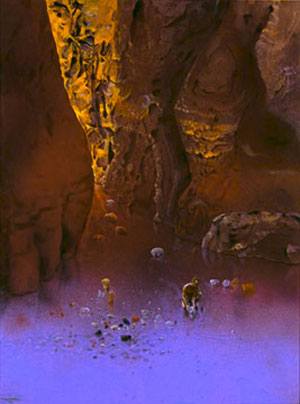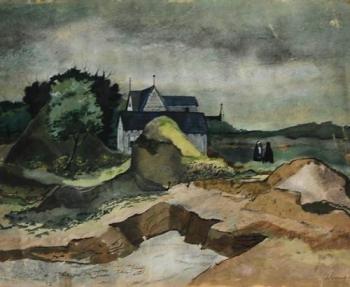
Kelly Fearing, “Man Arranging Rocks Where Water Reflects the Sky.” Oil on canvas, 1964
Kelly Fearing was one of the first Texas artists to reject the bluebonnets, cowboys and secondhand Impressionism that had been the mainstays of the state’s artistic output since the end of the 19th century. Along with the other members of the Fort Worth Circle, Fearing introduced Texas to European Modernists like Picasso and Miró. He forced his Texas audiences to confront the abstract, the allegorical and the surreal, all of which were alien to them.
Fearing was an accomplished purveyor of gorgeous but undeniably strange images. In a 2000 interview, Fearing said, “We were considered way out at the time. But we were just doing what we liked.” This individualism bordering on eccentricity made Fearing into one of Texas’ most important Modernists.
After Fearing’s death in 2011, Mark Smith, the director of Austin’s Flatbed Press, said, “On the strength of his art alone, Kelly Fearing was a national treasure. There are hundreds of art teachers in this country who were inspired by Kelly’s lifelong devotion to visual art.”
Fearing was born in 1918 in Fordyce, Arkansas, a small community in the state’s rural south. Fearing did not set out to become an artist. His first college major was accounting. He eventually transferred to Louisiana Tech University in Ruston, Louisiana and later received a master’s degree from Columbia University.
Equipped with an appreciation for the European avant-garde, Fearing migrated to Fort Worth in 1943. There, he had the good fortune to find an established cadre of like-minded artists: artists who were indifferent to Regionalism and other conservative tendencies. Fired by Surrealism and European abstraction, and united in their shared zeal for the fantastic, the artists of the Fort Worth Circle – as they were later known – made a beachhead for forward-thinking art in Texas. The members of the Circle, Fearing included, were chronicled in a 2008 exhibit at the Amon Carter Museum of American Art. Jane Myers, the Museum’s senior curator of prints and drawings and the organizer of the exhibition, said, upon its opening, “Many of the works in the exhibition will be making their first public appearance in more than 50 years. Together, the works will reveal a fascinating story of vibrant and vitalized collaborations and friendships, and they will tell the tale of how progressive art came to Texas.”

Kelly Fearing, Untitled, Oil on canvas, No date

Kelly Fearing, Untitled (Landscape), Gouache on paper, 1947
Fearing’s paintings from his Fort Worth years are surreal and often traffic in mythic, metaphysical themes. Spirituality was central to Fearing’s art; St. Francis of Assisi recurring character in the artist’s paintings and, later in life, he travelled to India to study with the mystic Bhagwan Shree Rajneesh. Fearing’s works, though informed by a searching and analytical spirituality, were not intended to be religious works, per se. For Fearing, spirituality was a source of inspiration. He once explained, “I am not a religious painter. I use the saints because they were in impossible situations.” The saints, and other religious figures provided Fearing with magical narratives that he could access, investigate and illustrate in his art.
The Fort Worth Circle, always a small alliance of artists, were prominent for most of the 1940s. They did not seek attention or notoriety, however, and then eschewed institutional support. Some nights they put aside their experimental engravings and, helped by the sherry they all adored, broke out into impromptu dancing. Fearing told an interviewer, “We weren’t interested in selling. We didn’t even exhibit…much.” This indifference to fame likely robbed the members of the Circle of the fame they deserved but it probably accounts for their wild, uncategorizable and enigmatic output; this was not art for intended for staid, bourgeois sensibilities.

Kelly Fearing, The Collector
Fearing taught for two years at Texas Wesleyan University in Fort Worth and moved to Austin in 1947, where he began teaching at the University of Texas art department. The department was, when Fearing arrived, quite new and was temporarily housed in a barracks from World War II. The department lacked a university museum, galleries and most of the other resources art departments rely on. Fearing taught at the University for four decades however, and watched it develop into a prominent art education institution.
Fearing retired from teaching in 1987, but continued to paint until his death in 2011. His works were exhibited throughout Texas during his lifetime and now reside in the Modern Art Museum of Fort Worth, the Dallas Museum of Art, and the Grace Museum, in Abilene, Texas.
Fearing long confounded critics; he was, in his time, called a “magical realist,” a “mystical naturalist,” and a “Romantic surrealist.” But applying a title to Fearing’s work does the artist a disservice. Fearing was an explorer, whose uncanny and odd images gave audiences access to a strange yet accessible place beyond the realm of the possible.